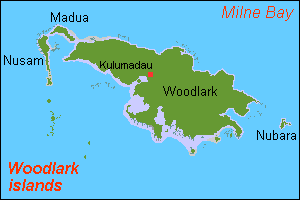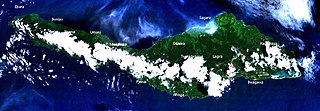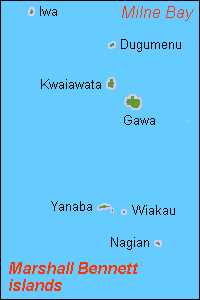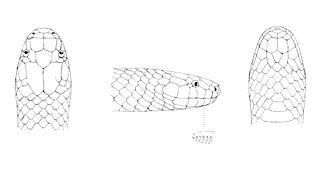
The Boidae, commonly known as boas or boids, are a family of nonvenomous snakes primarily found in the Americas, as well as Africa, Europe, Asia, and some Pacific islands. Boas include some of the world's largest snakes, with the green anaconda of South America being the heaviest and second-longest snake known; in general, adults are medium to large in size, with females usually larger than the males. Six subfamilies comprising 15 genera and 54 species are currently recognized.

Bougainville Island is the main island of the Autonomous Region of Bougainville, which is part of Papua New Guinea. It was previously the main landmass in the German Empire-associated North Solomons. Its land area is 9,300 km2 (3,600 sq mi). The population of the whole province, including nearby islets such as the Carterets, is approximately 300,000. The highest point is Mount Balbi, on the main island, at 2,715 m (8,907 ft). The much smaller Buka Island, c. 500 km2 (190 sq mi), lies to the north, across the 400–500 m (1,300–1,600 ft) wide Buka Strait. Even though the strait is narrow, there is no bridge across it, but there is a regular ferry service between the key settlements on either side. The main airport in the north is in the town of Buka.

Milne Bay is a province of Papua New Guinea. Its capital is Alotau. The province covers 14,345 km² of land and 252,990 km² of sea, within the province there are more than 600 islands, about 160 of which are inhabited. The province has about 276,000 inhabitants, speaking about 48 languages, most of which belong to the Eastern Malayo-Polynesian branch of the Austronesian language family. Economically the province is dependent upon tourism, oil palm, and gold mining on Misima Island; in addition to these larger industries there are many small-scale village projects in cocoa and copra cultivation. The World War II Battle of Milne Bay took place in the province.

Madau is an island of the Woodlark Islands group, in the Solomon Sea and Milne Bay Province of Papua New Guinea.

Misima is a volcanic island in the northwest of Louisiade Archipelago within Milne Bay Province of Papua New Guinea.
Albert Stewart Meek was an English bird collector and naturalist.

Candoia is a genus of non-venomous boas found mostly in New Guinea, Melanesia and the Maluku Islands in Indonesia. Common names include bevel-nosed boas and keel-scaled boas.
The 2007 Solomon Islands earthquake took place on 2 April 2007, near the provincial capital of Gizo on Ghizo Island, in the Solomon Islands. Its magnitude was estimated at 8.1 on the scale, and 7.8 on the scale. The tsunami that followed the earthquake killed 52 people. According to the USGS, the earthquake was recorded around 7:39:56 a.m. local time (UTC+11). The focus was 10 km (6 mi) deep and 40 km (25 mi) south southeast of Gizo township on New Georgia Islands in Western Province. There were numerous aftershocks, the largest of which had a magnitude of 6.2.

This page is a list of districts of Papua New Guinea.
Ikanogavialis is an extinct genus of gavialid crocodilian. Fossils have been found in the Urumaco Formation in Urumaco, Venezuela and the Solimões Formation of Brazil. The strata from which remains are found are late Miocene in age, rather than Pliocene as was once thought. A possible member of this genus survived into the Late Holocene on Muyua or Woodlark Island in Papua New Guinea.

Iwa Island is an island located in the Solomon Sea, approximately 130 miles (200 km) from mainland New Guinea and 310 miles (500 km) from Port Moresby. It is part of the Marshall Bennett Islands group and considered part of Papua New Guinea.
Guasopa is a village on Woodlark Island, Milne Bay Province Papua New Guinea. It is served by Guasopa Airport. Its population during the 1990 census was 170, though it has since grown extensively. Guasopa is the location of the Guasopa Health Center; this health center serves as the regional health care center, and has a team of nine health workers who service the population of around 6,000 people on Woodlark Island. This team also provide support for the other aid posts on the island and carry out patrols to surrounding islands. There is one school in Guasopa, though most students in the area go to Kulumadau Primary School. Students must travel to Alotau on the mainland to attend secondary school.
Samarai-Murua District is a district of the Milne Bay Province of Papua New Guinea. Its capital is Murua. The population of the district was 58,590 at the 2011 census.

Toxicocalamus is a genus of snakes in the family Elapidae. The genus is endemic to New Guinea.

The Woodlark Basin is a young geologic structural basin located in the southwestern Pacific Ocean, found to the southeast of the island country of Papua New Guinea. The basin is an extensional basin that is actively spreading and has a seafloor spreading center. This basin lies between the Indo-Australian Plate and the Solomon microplate and is located between the Louisiade Archipelago, Woodlark Island to the north and the northern Solomon Islands. The Woodlark Basin has an interesting and complex geologic history dating back twenty million years to the initial opening of the basin; the spreading of the basin, however, has occurred within the past 3.6 million years.
Kulumadau is a large, rural non-village on Woodlark Island, Milne Bay Province Papua New Guinea. It is served by Guasopa Airport. Its population during the 1990 census was 242, though it has since grown extensively; its current population is reported to be about 2,500 people, but there are no official sources for this number, as the last official census was taken in 1990. There is a large primary school in Kulumadau, where 200 students are taught. Students must travel to Alotau on the mainland to attend secondary school. Kulumadau was built in the post-colonial times, and as such, is not considered a traditional village of Woodlark, however, since its inception, Kulumadau has been the primary population center on Woodlark Island.
Murua Rural LLG is a local-level government (LLG) of Milne Bay Province, Papua New Guinea.
Candoia paulsoni, also known as the Solomon Islands ground boa, is a species of boa native to the Maluku Islands and Melanesia. Five subspecies are recognized.
Samuel Booker McDowell Jr was an American herpetologist who worked on the comparative anatomy of turtles and snakes and studied snakes of Oceania.













